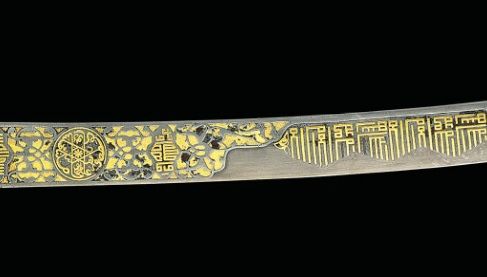An Ottoman Scimitar / Shamshir
Jul 9, 2013 13:35:18 GMT
Post by Jack Loomes on Jul 9, 2013 13:35:18 GMT



Price Realized
£34,850
Lot Description
AN OTTOMAN SWORD (SHAMSHIR)
SIGNED 'AJAMOGLU, OTTOMAN TURKEY, 18TH CENTURY
With typical curving single-edged watered-steel blade, decorated with a long angular kufic inscription as well as two rectangular cartouches containing further, similar inscriptions and roundel with radiating naskh, set on ground of scrolling vine engraved in relief with punched gilt ground, the rhino horn hilt with typical curved pommel, engraved silver cross bar and quillons, pins and central grip, the leather covered wooden scabbard with engraved silver fittings on either end with floral decoration, two engraved silver belt hooks, with sah marks on silver fittings, in good condition
36¼in. (92cm.) long.
Lot Notes
A sword signed by the same maker, spelled Acemoglu in Turkish, is in the Furusiyya Art Foundation Collection (Bashir Mohammed, The Arts of the Muslim Knight, Milan, 2007, no.39, p.75). Each blade has a slightly different curvature. Here the curve starts earlier and is more continuous along the length, amounting to a greater change of angle by the time the tip is reached. Each blade is noticeably thinner and more elegant in proportion than those of most Ottoman swords. The decoration of each is also very different. In the Furusiyya blade the main decoration is a nasta'liq quatrain inlaid into the blade. Here there is a great variety of scripts and tehcniques, with both inlay and overlay being used. Typical of this period however is the arabesque panels set against a ring-pounced gilded ground, a feature that is found on both blades. The maze kufic with wavy skyline is a feature that was first used in the 16th century on sword blades (for example one in the Askeri Museum in Istanbul, inv.no.1852). The decoration on the present blade is therefore considerably more archaic in inspiration than that of the Furusiyya example. In the note on the Furusiyya example Bashir Mohamed notes its similarity to a blade in the Metropolitan Museum of Art signed by Isma'il al-Farghani and dated 1217 (1802-3 AD).
Source: www.christies.com/

.png?width=1920&height=1080&fit=bounds)